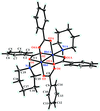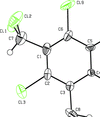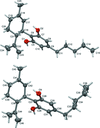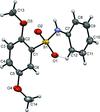issue contents
February 2017 issue

Cover illustration: In the 1,2,4-triazole–thione derivative, (E)-2-({[3-Benzylsulfanyl-5-(p-tolyl)-4H-1,2,4-triazol-4-yl]imino}methyl)phenol, the three aryl rings are inclined to the 1,2,4-triazole ring by 88.66 (8), 24.48 (8) and 17.97 (7)°. In the crystal, molecules are linked by O—H⋯N hydrogen bonds, forming chains propagating along the b-axis direction. See: Hou, Li & Wang [IUCrData (2017). 2, x170211].
inorganic compounds
Download citation


Download citation


Open  access
access
 access
accessThe title compound, Ba2VO4Br, crystallizes in the orthorhombic space group Pbcm. Its crystal structure is isotypic with the structure of chlorspodiosite, Ca2PO4Cl.
CCDC reference: 1531965
metal-organic compounds
Download citation


Download citation


Open  access
access
 access
accessIn the crystal structure of the title compound, planar [PdCl2{(C6H4)(NH2)2}] molecules are stacked into columns along the c axis, suggesting Pd⋯Pd interactions.
CCDC reference: 1055178
Download citation


Download citation


Open  access
access
 access
accessThe dimeric rhodium(II) complex of [Rh2(bzt)4(pip)2] is presented. The complex lies across an inversion centre with the unique RhII ion in a slightly distorted octahedral coordination environment.
CCDC reference: 1531658
Download citation


Download citation


Open  access
access
 access
accessIn the neutral RuII complex with 1,10-phenanthroline-5,6-dione, carbonyl and chloride ligands, the coordination sphere of the RuII atoms is that of a slightly distorted C2N2Cl2 octahedron, with the Cl atoms in a trans and the CO ligands in a cis configuration.
CCDC reference: 1533844
Download citation


Download citation


Open  access
access
 access
accessThe copper ion in the title complex adopts an axially elongated octahedral coordination geometry with the two bidentate organic ligands in equatorial positions and the two monodentate perchlorate ions in axial sites. Intermolecular N—H⋯O and C—H⋯O hydrogen bonds lead to the formation of layers parallel to (101).
CCDC reference: 1533763
Download citation


Download citation


Open  access
access
 access
accessThe asymmetric unit of the title compound contains an amidinate ligand and tin(II) bromide. The crystal structure features N—H⋯Br hydrogen bonds.
CCDC reference: 1534782
organic compounds
Download citation


Download citation


Open  access
access
 access
accessIn the crystal, molecules are connected by bifurcated N—H⋯(N,O) and N—H⋯(O,O) hydrogen bonds, generating (100) sheets.
CCDC reference: 1527554
Download citation


Download citation


Open  access
access
 access
accessThe crystal packing consists of bilayers parallel to (001) generated by three C—H⋯O hydrogen bonds.
CCDC reference: 1528393
Download citation


Download citation


Open  access
access
 access
accessIn the title compound, the mean plane of the methoxyphenyl ring makes dihedral angles of 51.63 (8) and 50.86 (8)° with the terminal phenyl rings.. The crystal structure features C—H⋯O hydrogen bonds.
CCDC reference: 1526406
Download citation


Download citation


Open  access
access
 access
accessThe asymmetric unit of the title compound consists of two independent molecules. In the crystal, C—H⋯X (X = Cl, N, O) hydrogen bonds and C—H⋯π and π-stacking interactions are observed: together these generate a three-dimensional network.
CCDC reference: 1529978
Download citation


Download citation


Open  access
access
 access
accessIn the crystal, molecules are linked via pairs of weak C—H⋯O hydrogen bonds, forming the inversion dimers with ![[R_{2}^{2}]](/x/issues/2017/02/00/xu4023/teximages/xu4023fi1.gif) (10) ring motifs.
(10) ring motifs.
![[R_{2}^{2}]](/x/issues/2017/02/00/xu4023/teximages/xu4023fi1.gif) (10) ring motifs.
(10) ring motifs.CCDC reference: 1529536
Download citation


Download citation


Open  access
access
 access
accessThe indolinone moieties are nearly planar and an intramolecular C=O⋯π interaction between the carbonyl group of one indolin-2-one system and the five-membered ring of the other helps to determine the molecular conformation. N—H⋯O hydrogen bonds generate zigzag chains of molecules running parallel to the b-axis direction that form sheets parallel to (001) through pairwise O—H⋯O hydrogen bonds and complementary π–π stacking between the indolinone ring systems.
CCDC reference: 1529856
Download citation


Download citation


Open  access
access
 access
accessThe `pincer' conformation adopted by the title molecule is due in part to two intramolecular C—H⋯π(ring) interactions. Pairwise N—H⋯N hydrogen bonds link molecules into dimers which are then formed into a three-dimensional net through three sets of C—H⋯S hydrogen bonds and a set of C—H⋯π(ring) interactions.
CCDC reference: 1530082
Download citation


Download citation


Open  access
access
 access
accessThere are two organic molecules and one water molecule in the asymmetric unit of the title compound. The molecules are connected through a water molecule via N—H⋯O and O—H⋯O hydrogen bonds.
CCDC reference: 1530045
Download citation


Download citation


Open  access
access
 access
accessIn the title compound, the indole ring system makes dihedral angles of 87.24 (1) and 77.58 (1)° with the fluorobenzene and phenyl rings, respectively. The molecular structure is stabilized by a C—H⋯O and a C—H⋯Br intramolecular hydrogen bond, which generate S(6) and S(8) ring motifs, respectively.
CCDC reference: 1530001
Download citation


Download citation


Open  access
access
 access
access3-Methyl-4,5,6,7,8,9-hexahydrocycloocteno-1,2,3-selenadiazolium iodide–trichloromethane (4/1)
The asymmetric unit contains four very similar ion pairs and one solvent molecule. In the crystal, layers of parallel chloroform-filled channels formed by two different ion pairs alternate with layers formed by the other two ion pairs.
CCDC reference: 815133
Download citation


Download citation


Open  access
access
 access
accessIn the title crystal, 3,5-diamino-4H-1,2,4-triazol-1-ium cations, 4-nitrobenzoate anions and water molecules are linked by N—H⋯O, N—H⋯N, O—H⋯O, C—H⋯O and π–π interactions to form layers parallel to (![[\overline{1}]](/x/issues/2017/02/00/tk4030/teximages/tk4030fi1.gif) 01).
01).
![[\overline{1}]](/x/issues/2017/02/00/tk4030/teximages/tk4030fi1.gif) 01).
01).CCDC reference: 1530351
Download citation


Download citation


Open  access
access
 access
accessIn the solid state structure of the title compound, the N atoms are protonated and the C—O− bond lengths are 1.265 (2) Å, hence the compound crystallizes as a double zwitterion, with intramolecular N—H⋯O hydrogen bonds forming S(6) ring motifs. The whole molecule is generated by twofold rotational symmetry, with the twofold axis bisecting the central –CH2—CH2– bond of the bridging octane chain.
CCDC reference: 1530499
Download citation


Download citation


Open  access
access
 access
accessIn the crystal of the title compound, molecules are linked by pairwise N—H⋯N and C—H⋯N hydrogen bonds, forming ribbons running along the a-axis direction. The ribbons are connected by C—H⋯Cl hydrogen bonds, forming a three-dimensional supramolecular structure.
CCDC reference: 1530588
Download citation


Download citation


Open  access
access
 access
accessThe molecules of the title compound exhibit twofold rotational symmetry, and the fluorocarbon chains adopt helical conformation.
CCDC reference: 1528993
Download citation


Download citation


Open  access
access
 access
accessIn the crystal of the title compound, molecules are linked by N—H⋯O hydrogen bonds and C—H⋯π interactions, forming slabs parallel to the ac plane.
CCDC reference: 1520636
Download citation


Download citation


Open  access
access
 access
accessThe title compound, C20H19N5S, adopts a `contorted' conformation: the dihedral angle between the heterocyclic rings is 86.54 (6)°.
CCDC reference: 1530646
Download citation


Download citation


Open  access
access
 access
accessThe title compound is non-planar with the phenyl ring of the phenethylacetamide residue is inclined to the benzofuran ring system by 84.8 (3)°. In the crystal, N—H⋯O hydrogen bonds together with π–π stacking interactions, stabilize the structure.
CCDC reference: 1503758
Download citation


Download citation


Open  access
access
 access
accessIn the crystal of the title compound, molecules are linked by O—H⋯O hydrogen bonds, forming a trimer with an ![[R_{3}^{3}]](/x/issues/2017/02/00/su4069/teximages/su4069fi1.gif) (6) ring motif.
(6) ring motif.
![[R_{3}^{3}]](/x/issues/2017/02/00/su4069/teximages/su4069fi1.gif) (6) ring motif.
(6) ring motif.CCDC reference: 1491695
Download citation


Download citation


Open  access
access
 access
accessThe asymmetric unit of the title salt contains two glutaminium cations and two 4-methylbenzenesulfonate anions. The crystal packing features weak intermolecular C—H⋯O, O—H⋯O and N—H⋯O hydrogen bonds.
CCDC reference: 1530383
Download citation


Download citation


Open  access
access
 access
accessThe title molecule is a Schiff base. It is approximately planar, with the highest deviation from planarity of 0.096 (4) Å for the methyl C atom of the methoxy group.
CCDC reference: 1530590
Download citation


Download citation


Open  access
access
 access
accessThe iodoquinolinyl moiety (r.m.s. deviation = 0.044 Å) makes dihedral angles of 87.44 (10) and 88.64 (10)° with the chloro- and methoxy-substituted benzene rings, respectively. The crystal features relatively strong methoxybenzene-C—H⋯O(quinolinyl) hydrogen bonds, leading to helical supramolecular chains along the a-axis direction. Additional C—H⋯O interactions along with π-stacking consolidate the three-dimensional molecular packing.
CCDC reference: 1047102
Download citation


Download citation


Open  access
access
 access
accessIn the title compound, the dihedral angle between the mean planes of the two aromatic rings is 66.55 (8)°. The crystal packing features by intermolecular C—H⋯O contacts.
CCDC reference: 1530685
Download citation


Download citation


Open  access
access
 access
accessThe title pyranopyran derivative is planar, with an r.m.s. deviation of 0.042 Å. In the crystal, molecules are linked by C—H⋯O hydrogen bonds, involving the same acceptor atom and enclosing an ![[R_{2}^{1}]](/x/issues/2017/02/00/su4128/teximages/su4128fi1.gif) (6) ring motif, forming chains propagating along [001].
(6) ring motif, forming chains propagating along [001].
![[R_{2}^{1}]](/x/issues/2017/02/00/su4128/teximages/su4128fi1.gif) (6) ring motif, forming chains propagating along [001].
(6) ring motif, forming chains propagating along [001].CCDC reference: 1531805
Download citation


Download citation


Open  access
access
 access
accessThe structure of the title bis-chalcone derivative, which has crystallographic mirror symmetry, is reported.
CCDC reference: 1449583
Download citation


Download citation


Open  access
access
 access
accessIn the crystal, the asymmetric unit contains two independent molecules with almost identical conformations.
CCDC reference: 1531481
Download citation


Download citation


Open  access
access
 access
accessThe molecular and crystal structures of the title hydrated oxazolidinone derivative is reported. The two carbonyl groups are oriented anti to one another. In the crystal, O—H⋯O, C—H⋯O and C—H⋯F hydrogen bonds generate a three-dimensional supramolecular architecture.
CCDC reference: 1531856
Download citation


Download citation


Open  access
access
 access
accessIn the title 1,2,4-triazole–thione derivative, the three aryl rings are inclined to the 1,2,4-triazole ring by 88.66 (8), 24.48 (8) and 17.97 (7)°. In the crystal, molecules are linked by O—H⋯N hydrogen bonds, forming chains propagating along the b-axis direction.
CCDC reference: 1531827
Download citation


Download citation


Open  access
access
 access
accessThe asymmetric unit of the title compound, C9H3Cl9, contains one molecule. Two slightly different conformations with nearly C3 h symmetry are mutually disordered in a 1:1 ratio. This disorder enhances the overall structural symmetry to D3h.
CCDC reference: 1532083
Download citation


Download citation


Open  access
access
 access
accessThe asymmetric unit of the title salt comprises one half of the piperazine-1,4-diium dication lying on a twofold rotation axis and one 3-carboxy-2,3-dihydroxypropanoate anion.
CCDC reference: 1532469
Download citation


Download citation


Open  access
access
 access
accessIn the crystal packing of the title compound, C7H6N2Se, the molecules are arranged in rods along the b axis and form dimeric units due to intermolecular Se⋯N contacts of 2.982 (2) Å. The molecules are further linked by weak π–π stacking interactions between the 2,1,3-selenadiazole and six-membered aromatic rings [centroid–centroid distance = 3.8509 (11) Å abd ring slippage = 1.539 (3) Å].
CCDC reference: 1532046
Download citation


Download citation


Open  access
access
 access
accessThe molecular and crystal structure of the title triazole derivative is reported. In the crystal, molecules are linked by weak C—H⋯O and C—H⋯F hydrogen bonds, forming a three-dimensional supramolecular structure.
CCDC reference: 1532447
Download citation


Download citation


Open  access
access
 access
accessThe structure of the title bis-chalcone derivative, which has crystallographic inversion symmetry, is reported. The crystal structure features C—H⋯O and C—H⋯F hydrogen bonds.
CCDC reference: 1449627
Download citation


Download citation


Open  access
access
 access
accessIn the crystal, molecules are linked via pairs of C—H⋯O hydrogen bonds, forming inversion dimers with ![[R_{2}^{2}]](/x/issues/2017/02/00/hb4125/teximages/hb4125fi1.gif) (16) ring motifs.
(16) ring motifs.
![[R_{2}^{2}]](/x/issues/2017/02/00/hb4125/teximages/hb4125fi1.gif) (16) ring motifs.
(16) ring motifs.CCDC reference: 1532444
Download citation


Download citation


Open  access
access
 access
accessThe title zwitterion features an intramolecular N—H⋯O hydrogen bond. In the crystal, aromatic π–π stacking occurs [shortest centroid–centroid distance = 3.574 (3) Å] and C—H⋯O interactions are also observed.
CCDC reference: 1532675
Download citation


Download citation


Open  access
access
 access
accessThe molecular and crystal structures of the title pyrazolone derivative are reported. The crystal packing features N—H⋯O, N—H⋯N and C—H⋯N hydrogen bonds and a π–π stacking interaction.
CCDC reference: 1532587
Download citation


Download citation


Open  access
access
 access
accessIn the title imidoyl chloride, the dihedral angle between the 4,6-dichloroquinoline ring system and the 3-chlorophenyl ring is 18.20 (4)°.
CCDC reference: 1533438
Download citation


Download citation


Open  access
access
 access
accessThe title organic salt, synthesized by methylating 4-picoline with methyl iodide, crystallized with three independent 1,4-dimethylpyridinium cations and three independent iodide anions in the asymmetric unit.
CCDC reference: 1533238
Download citation


Download citation


Open  access
access
 access
accessThe complete molecule of 1,4-bis(1H-1,2,4-triazol-1-yl)benzene is generated by inversion symmetry.
CCDC reference: 1533318
Download citation


Download citation


Open  access
access
 access
accessThe title compound crystallizes as a hydrated zwiterion.
CCDC reference: 1533317
Download citation


Download citation


Open  access
access
 access
accessThe title compound is built up from a four-membered ring to which a six- and a five-membered ring are fused. In the crystal, molecules are linked by N—H⋯O hydrogen bonds, forming chains propagating along the b-axis direction.
CCDC reference: 1533486
Download citation


Download citation


Open  access
access
 access
accessIn the crystal, the asymmetric unit contains two independent molecules with an almost identical conformation.
CCDC reference: 1532588
Download citation


Download citation


Open  access
access
 access
accessThe molecular and crystal structure of the title chalcone derivative is reported. In the crystal, molecules are linked by weak hydrogen bonds, forming chains propagating along the c-axis direction.
CCDC reference: 1036742
Download citation


Download citation


Open  access
access
 access
accessThe crystal structure of the title pyrazole derivative is stabilized by a variety of hydrogen bonds and two C—H⋯π(ring) contacts.
CCDC reference: 1532509
Download citation


Download citation


Open  access
access
 access
accessThe cation is protonated at the amine N atom and the anion is deprotonated at the hydroxy O atom of the sulfonate group. The crystal structure features N—H⋯O and O—H⋯O hydrogen bonds.
CCDC reference: 1532573
Download citation


Download citation


Open  access
access
 access
accessThe title compound is a diacetylene derivative. In the crystal, the molecules are linked by C—H⋯π interactions, forming centrosymmetric dimers.
CCDC reference: 1533495
Download citation


Download citation


Open  access
access
 access
accessThe title racemic spiro compound, crystallizes with two independent molecules (A and B) in the asymmetric unit in whch the mean plane of the phenanthrene unit is twisted by 82.38 (5) and 80.25 (5)° with respect to the mean plane of the fluorene unit. In the crystal, the A and B molecules are linked by a pair of C—H⋯O hydrogen bonds, and a pair of short Br⋯O contacts [2.935 (2) Å], forming a centrosymmetric four-molecule unit.
CCDC reference: 1534283
Download citation


Download citation


Open  access
access
 access
accessA high-quality structure determination of cannabidiol was possible using the rather uncommon Cu Kβ wavelength radiation, and confirmed the absolute structure to be R,R.
CCDC reference: 1533487
Download citation


Download citation


Open  access
access
 access
accessIn the title compound, the benzodioxole and dihydroisoxazole units are bridged by a methylene group. The dihydroisoxazole ring is syn-clinal with respect to the benzodioxole, while the pyridine is anti-periplanar to the adjacent benzene ring.
CCDC reference: 1533548
Download citation


Download citation


Open  access
access
 access
accessThe title compound is L-shaped and the dihedral angle between the benzene rings is 89.17 (9)°.
CCDC reference: 1534581


 journal menu
journal menu


































































![[publCIF]](/logos/authorchecklist11.gif)





